The bifacial solar module market, estimated at USD 201.8 billion in 2025 and projected to reach USD 486.6 billion by 2035 with a CAGR of 9.2%, reflects a significant transformation in the solar energy value chain driven by the adoption of bifacial technology. The cost structure of bifacial solar modules is heavily influenced by raw material procurement, particularly high-purity silicon wafers, specialized transparent backsheet materials, and advanced glass, which together account for a substantial portion of production costs.
Module fabrication involves precision cell interconnection, encapsulation, and lamination processes that contribute to both capital and operational expenditures, while the integration of bifacial designs introduces additional complexity and slightly higher manufacturing costs compared to conventional monofacial modules. The value chain extends from raw material suppliers to cell manufacturers, module assemblers, and distributors, with downstream deployment in utility-scale solar farms, commercial installations, and residential rooftops. System integrators and engineering, procurement, and construction providers play a critical role in optimizing installation efficiency and performance, thereby influencing overall cost-effectiveness.
Economies of scale in production and improvements in bifacial efficiency are expected to gradually reduce per-unit costs over the forecast period, enhancing market attractiveness. The bifacial solar module market demonstrates a cost-sensitive yet innovation-driven value chain, where upstream material sourcing and technological improvements in module assembly directly affect market growth, profitability, and adoption rates across global solar deployments.
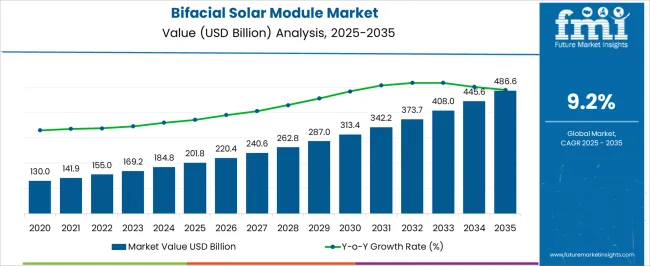
| Metric | Value |
|---|---|
| Bifacial Solar Module Market Estimated Value in (2025 E) | USD 201.8 billion |
| Bifacial Solar Module Market Forecast Value in (2035 F) | USD 486.6 billion |
| Forecast CAGR (2025 to 2035) | 9.2% |
The bifacial solar module market represents a specialized segment within the global solar photovoltaics industry, emphasizing enhanced energy capture, efficiency, and innovative panel design. Within the overall solar module market, it accounts for about 5.6%, driven by adoption in utility scale, commercial, and residential installations. In the renewable energy generation segment, it holds nearly 6.2%, reflecting its ability to harvest sunlight from both front and rear surfaces, improving overall energy yield. Across the solar power systems and energy storage sector, the segment captures 4.8%, supporting integration with inverters, trackers, and microgrid solutions.
Within the high efficiency and next generation photovoltaics category, it represents 4.3%, highlighting its role in reducing land use and maximizing output. In the global clean energy infrastructure and decarbonization initiatives sector, it secures 3.9%, emphasizing environmental compliance and reduced carbon footprint. Recent developments in this market have focused on efficiency optimization, bifacial cell design, and integration with tracking systems. Innovations include PERC and heterojunction technologies to improve rear side energy capture and module durability. Key players are collaborating with solar project developers and EPC contractors to deploy bifacial modules in utility scale and commercial applications.
Adoption of advanced mounting, reflectors, and single axis trackers is gaining traction to maximize energy yield. The testing standards, durability certifications, and AI-based performance monitoring are being integrated to improve reliability and long term output. These trends demonstrate how technological innovation, energy efficiency, and sustainable deployment are shaping the bifacial solar module market.
The bifacial solar module market is experiencing accelerated expansion, driven by the rising demand for high-efficiency photovoltaic solutions and the global shift toward renewable energy. Industry developments and project deployment reports have emphasized the ability of bifacial modules to capture sunlight from both sides, significantly increasing energy yield compared to traditional monofacial panels.
Utility-scale solar projects, in particular, have adopted bifacial technology to maximize return on investment and lower the levelized cost of electricity (LCOE). Technological advancements in cell architecture, encapsulation materials, and module durability have enhanced performance in diverse environmental conditions.
Government incentives, renewable energy targets, and corporate decarbonization commitments have further fueled adoption. The market is also benefiting from falling manufacturing costs, optimized tracking systems, and improved bifacial gain modeling, which have bolstered confidence among investors and developers. Future growth is expected to be led by thinner glass configurations for weight reduction, dual-glass designs for superior durability, and utility applications that capitalize on the efficiency gains and long-term reliability of bifacial modules.
The bifacial solar module market is segmented by thickness, type, application, technology, frame type, and geographic regions. By thickness, bifacial solar module market is divided into 2 mm, 2 mm to 3 mm, and > 3 mm. In terms of type, bifacial solar module market is classified into Dual-Glass Bifacial Solar and Glass-Backsheet Bifacial Solar. Based on application, bifacial solar module market is segmented into Utility, Residential, and Commercial & Industrial. By technology, bifacial solar module market is segmented into Passivated Emitter Rear Contact (PERC), TOPCon, and Heterojunction (HJT). By frame type, bifacial solar module market is segmented into Framed and Frameless. Regionally, the bifacial solar module industry is classified into North America, Latin America, Western Europe, Eastern Europe, Balkan & Baltic Countries, Russia & Belarus, Central Asia, East Asia, South Asia & Pacific, and the Middle East & Africa.
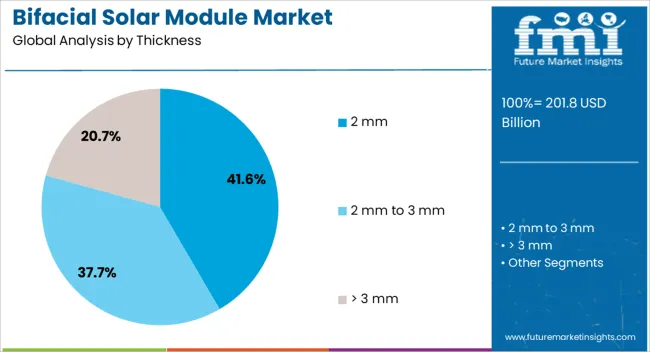
The 2 mm thickness segment is projected to account for 41.6% of the bifacial solar module market revenue in 2025, supported by its ability to balance structural integrity with weight reduction. Manufacturers have increasingly adopted thinner glass to enhance module handling during installation and reduce overall system load, which is especially important for large-scale utility projects and rooftop deployments with weight restrictions.
Glass technology advancements have enabled 2 mm glass to maintain mechanical strength while offering improved light transmittance to the rear side of the module, enhancing bifacial gain.
Production efficiency improvements and cost optimization in glass manufacturing have also supported the wider adoption of this thickness specification. As developers seek to lower logistics costs and expand installation versatility without compromising module durability, the 2 mm thickness segment is expected to retain its strong market position.
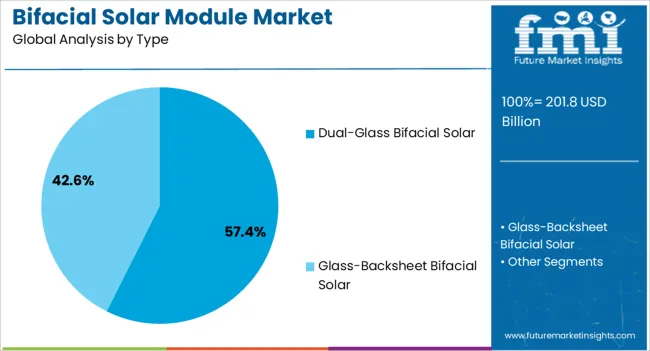
The dual-glass bifacial solar segment is projected to contribute 57.4% of the market revenue in 2025, maintaining its lead due to its superior durability and enhanced energy yield. This configuration replaces the polymer backsheet with a second glass layer, providing better protection against moisture ingress, UV degradation, and mechanical stress.
Field performance data has shown that dual-glass modules maintain lower degradation rates over their operational life, translating into higher long-term energy output.
Additionally, the added rear-side glass improves light capture from reflected and diffused sources, further boosting energy generation efficiency. Large-scale utility developers and financiers have favored dual-glass designs for their extended warranties and proven resilience in harsh climates. With the ongoing focus on maximizing lifecycle performance and reducing maintenance costs, the dual-glass bifacial solar segment is expected to remain the preferred choice for high-reliability solar installations.
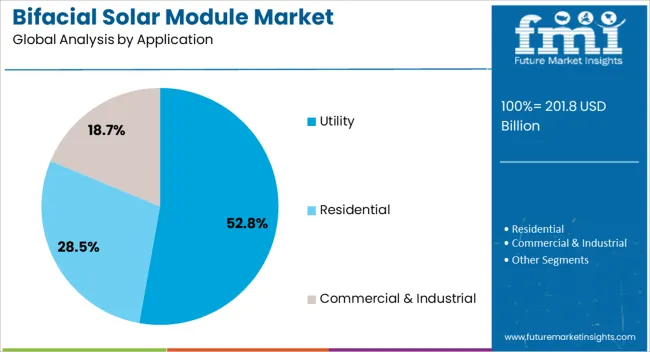
The utility segment is projected to hold 52.8% of the bifacial solar module market revenue in 2025, reflecting its dominant role in driving large-scale adoption of bifacial technology. Utility-scale projects benefit most from bifacial modules’ higher energy yield, which directly reduces the levelized cost of electricity.
Project developers have increasingly deployed bifacial systems in conjunction with single-axis trackers, optimizing rear-side light capture and maximizing energy harvest over extensive installation areas.
Policy frameworks supporting renewable energy procurement, coupled with competitive power purchase agreements, have encouraged investment in utility projects using bifacial technology. Furthermore, the operational economics of bifacial modules in large arrays, such as reduced land requirements per unit of energy generated, have reinforced their appeal in utility-scale developments. With global utility solar capacity expanding rapidly to meet climate and energy transition goals, the utility segment is expected to sustain its leadership in the market.
The market has grown steadily as renewable energy adoption expands globally, driven by the demand for higher efficiency and improved energy yield. Bifacial modules capture sunlight from both front and rear surfaces, increasing power generation compared to traditional monofacial panels. These modules are increasingly deployed in utility-scale solar farms, commercial rooftops, and floating solar projects, where reflected light from surfaces enhances energy output. Technological advancements in cell design, materials, and mounting structures have improved bifacial performance and durability. Incentives for clean energy, declining module costs, and growing environmental awareness among consumers and industries have accelerated adoption.
Utility-scale solar farms have become a key driver for bifacial solar modules as developers seek to maximize energy yield per land area. Ground-mounted systems can capture reflected irradiance from high-albedo surfaces, such as concrete, sand, or gravel, increasing the energy output of large-scale projects. These installations benefit from optimized tilt angles, tracking systems, and spacing configurations to exploit both front and rear irradiation. Developers are increasingly selecting bifacial modules for mega-projects to meet renewable energy targets and improve return on investment. The governments and regulatory bodies encourage large-scale solar generation through subsidies and incentives. The combination of financial benefits, energy efficiency gains, and long-term operational reliability has reinforced the deployment of bifacial modules in utility-scale solar applications.
Commercial and industrial rooftops are emerging as significant adopters of bifacial solar modules due to their ability to increase power output without requiring additional rooftop area. Bifacial modules optimize energy production from reflective building surfaces, reducing electricity costs for manufacturers, warehouses, and corporate facilities. Integrating energy management systems with bifacial installations allows for monitoring, load optimization, and improved efficiency. Companies seeking sustainable energy solutions and carbon footprint reduction increasingly favor bifacial technology. The ability to combine bifacial panels with energy storage systems, net metering, or microgrid configurations further enhances economic benefits. As corporate sustainability targets intensify and rooftop space becomes a critical factor, bifacial solar modules are positioned as an effective solution for maximizing renewable energy generation.
Technological advancements have strengthened the performance, reliability, and economic viability of bifacial solar modules. Innovations in multi-busbar cell design, transparent backsheet materials, and advanced anti-reflective coatings have increased bifacial energy yield. Tracking systems and adjustable mounting structures optimize solar incidence angles on both surfaces, enhancing power generation throughout the day. Enhanced module encapsulation and improved thermal management have extended service life and reduced efficiency losses in high-temperature environments. Digital monitoring and predictive maintenance tools allow operators to maximize output while minimizing downtime. These innovations contribute to more consistent performance across diverse geographies and installation types, making bifacial modules increasingly competitive with monofacial alternatives and reinforcing their adoption in modern solar projects.
Despite their advantages, bifacial solar modules face challenges related to installation complexity and higher upfront costs. Optimizing tilt, height, and surface reflectivity is essential to achieving expected energy gains, which can require specialized design and engineering expertise. Structural considerations, such as wind load, snow accumulation, and mounting system compatibility, further add to installation intricacy. The initial capital expenditure is higher than for conventional monofacial panels, impacting the payback period, particularly in small-scale installations. Performance variability due to geographic conditions, albedo changes, or shading can reduce expected energy gains. The growing experience in system design, economies of scale in module manufacturing, and falling balance-of-system costs are gradually mitigating these challenges, supporting broader adoption of bifacial solar modules globally.
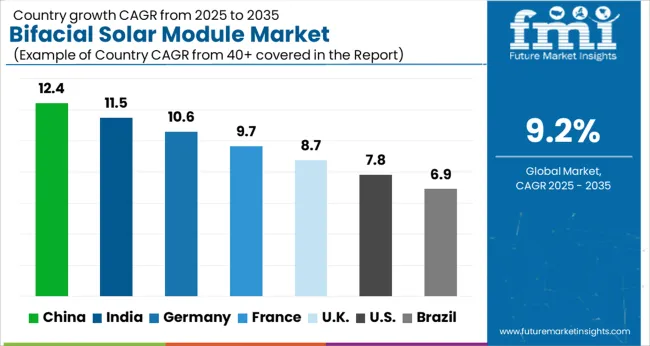
| Country | CAGR |
|---|---|
| China | 12.4% |
| India | 11.5% |
| Germany | 10.6% |
| France | 9.7% |
| UK | 8.7% |
| USA | 7.8% |
| Brazil | 6.9% |
The market has witnessed significant activity across leading nations, with India posting a forecast growth of 11.5% due to rising renewable energy installations and favorable policies. China follows with 12.4%, driven by widespread adoption of dual-sided panels in utility-scale projects. Germany achieved 10.6%, reflecting the use of bifacial technology in commercial and industrial solar rooftops. The United Kingdom recorded 8.7%, supported by ongoing research in high-efficiency photovoltaic solutions. The United States registered 7.8%, with gradual uptake in residential and utility-scale solar segments. These countries collectively exemplify the expansion, production, and technological innovation shaping the global trajectory of bifacial solar modules. This report includes insights on 40+ countries; the top markets are shown here for reference.
The market in China is expected to expand at a CAGR of 12.4%, driven by rapid adoption of advanced solar technologies to maximize energy generation. Increasing government initiatives to promote renewable energy, alongside declining costs of solar module production, are fueling demand. Large-scale solar farms and distributed rooftop installations are integrating bifacial modules to harness sunlight from both front and rear surfaces. Technological improvements in module efficiency, durability, and bifacial performance are further supporting market growth. The growing awareness of environmental sustainability and carbon reduction targets among industrial and commercial energy consumers is driving adoption of high-performance solar solutions.
India’s market is projected to grow at a CAGR of 11.5%, fueled by increasing renewable energy targets and government incentives for solar deployment. Bifacial modules are being utilized in utility-scale solar parks and commercial installations to improve energy yield and operational efficiency. Investment in solar infrastructure, along with declining costs and favorable financing options, is encouraging adoption. Technological advancements in module bifaciality ratio, durability, and low-light performance are driving market expansion. Moreover, rising corporate and industrial adoption to meet sustainability goals is contributing to growth, positioning India as a key market for high-efficiency solar technologies.
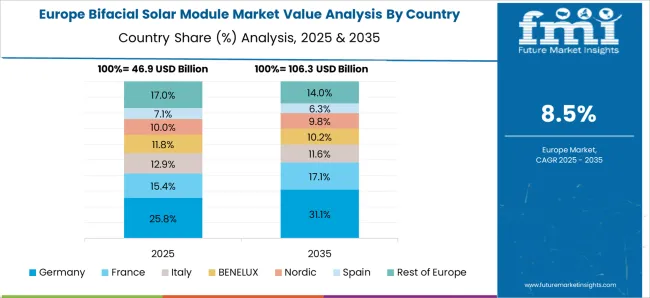
Germany is anticipated to grow at a CAGR of 10.6%, supported by strong regulatory frameworks promoting renewable energy integration. Increasing installation of bifacial modules in solar parks and commercial facilities is enhancing energy generation efficiency. Technological innovations, including improved module bifacial performance and resistance to environmental degradation, are supporting adoption. Expansion of government-backed incentives and feed-in tariffs is further driving growth. Industrial and municipal projects are increasingly incorporating bifacial solar technology to meet sustainability and energy efficiency targets. The rising focus on reducing carbon emissions and optimizing energy yields in both urban and rural solar installations is strengthening the market landscape.
The United Kingdom’s market is projected to expand at a CAGR of 8.7%, driven by increasing adoption of advanced solar technologies for higher energy yields. Bifacial modules are gaining traction in utility-scale solar parks and large rooftop installations, especially in industrial and commercial segments. Technological advancements improving module efficiency, light capture, and durability are positively influencing market growth. Government incentives, renewable energy mandates, and corporate sustainability goals are encouraging investments in bifacial solar systems. The rising awareness about energy optimization and carbon footprint reduction among public and private stakeholders is driving wider market acceptance.
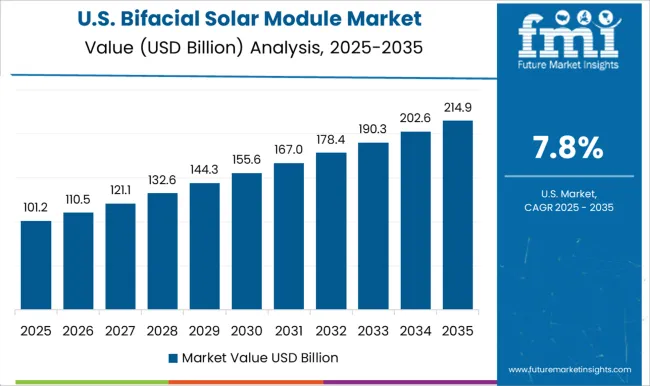
The United States is expected to grow at a CAGR of 7.8%, supported by increasing deployment in commercial, utility, and industrial solar projects. Bifacial modules are preferred for their ability to capture sunlight from both surfaces, enhancing energy yield in large installations. Technological advancements improving module efficiency, durability, and performance under various lighting conditions are encouraging adoption. Federal and state-level incentives, along with corporate sustainability initiatives, are boosting investment in bifacial solar systems. The focus on reducing greenhouse gas emissions and optimizing renewable energy production across multiple sectors is further strengthening market expansion.
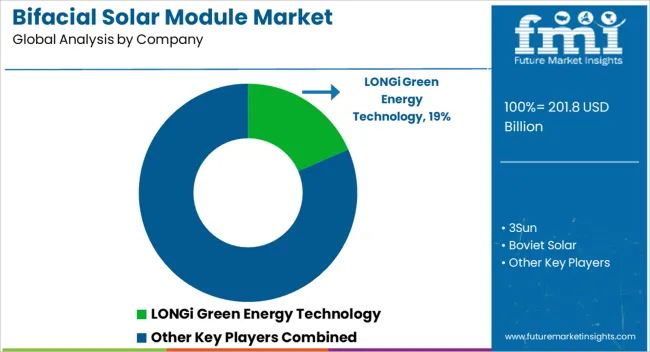
The market is increasingly driven by global leaders offering advanced photovoltaic solutions that capture sunlight from both front and rear surfaces, enhancing energy yield and efficiency. LONGi Green Energy Technology has established a strong presence with high-performance bifacial panels that optimize solar absorption while reducing degradation rates. 3Sun and Boviet Solar are recognized for innovative manufacturing processes and durable module designs suitable for large-scale utility and commercial projects. Canadian Solar, First Solar, Hanwha Q CELLS, and JA Solar Technology provide bifacial modules with enhanced bifaciality factors, enabling improved energy generation in diverse environmental conditions.
Jinko Solar and Trina Solar focus on cost-effective production and deployment scalability, supporting extensive adoption in utility and industrial solar farms. Vikram Solar and Reliance New Energy are expanding their offerings with high-efficiency bifacial panels designed to maximize energy output while maintaining sustainability standards. Sharp Corporation and Sunergy contribute specialized modules optimized for residential and commercial installations, emphasizing reliability, longevity, and energy performance. Together, these companies are driving technological innovation, supporting global renewable energy goals, and facilitating the transition toward higher-efficiency, bifacial solar solutions for a wide range of applications.
| Item | Value |
|---|---|
| Quantitative Units | USD 201.8 Billion |
| Thickness | 2 mm, 2 mm to 3 mm, and > 3 mm |
| Type | Dual-Glass Bifacial Solar and Glass-Backsheet Bifacial Solar |
| Application | Utility, Residential, and Commercial & Industrial |
| Technology | Passivated Emitter Rear Contact (PERC), TOPCon, and Heterojunction (HJT) |
| Frame Type | Framed and Frameless |
| Regions Covered | North America, Europe, Asia-Pacific, Latin America, Middle East & Africa |
| Country Covered | United States, Canada, Germany, France, United Kingdom, China, Japan, India, Brazil, South Africa |
| Key Companies Profiled | LONGi Green Energy Technology, 3Sun, Boviet Solar, Canadian Solar, First Solar, Hanwha Q CELLS, JA Solar Technology, Jinko Solar, Reliance New Energy, Sharp Corporation, Sunergy, Trina Solar, and Vikram Solar |
| Additional Attributes | Dollar sales by module type and application, demand dynamics across residential, commercial, and utility-scale solar installations, regional trends in bifacial technology adoption, innovation in efficiency, durability, and installation design, environmental impact of material use and lifecycle energy, and emerging use cases in dual-sided energy harvesting, agrivoltaics, and building-integrated photovoltaics. |
The global bifacial solar module market is estimated to be valued at USD 201.8 billion in 2025.
The market size for the bifacial solar module market is projected to reach USD 486.6 billion by 2035.
The bifacial solar module market is expected to grow at a 9.2% CAGR between 2025 and 2035.
The key product types in bifacial solar module market are 2 mm, 2 mm to 3 mm and > 3 mm.
In terms of type, dual-glass bifacial solar segment to command 57.4% share in the bifacial solar module market in 2025.






Full Research Suite comprises of:
Market outlook & trends analysis
Interviews & case studies
Strategic recommendations
Vendor profiles & capabilities analysis
5-year forecasts
8 regions and 60+ country-level data splits
Market segment data splits
12 months of continuous data updates
DELIVERED AS:
PDF EXCEL ONLINE
Solar Analyzer Market Size and Share Forecast Outlook 2025 to 2035
Solar Aluminum Alloy Frame Market Size and Share Forecast Outlook 2025 to 2035
Solar Grade Monocrystalline Silicon Rods Market Analysis - Size, Share, and Forecast Outlook 2025 to 2035
Solar Vehicle Market Size and Share Forecast Outlook 2025 to 2035
Solar Encapsulation Market Size and Share Forecast Outlook 2025 to 2035
Solar Pumps Market Analysis - Size, Share, and Forecast Outlook 2025 to 2035
Solar Mobile Light Tower Market Size and Share Forecast Outlook 2025 to 2035
Solar PV Recycling Market Size and Share Forecast Outlook 2025 to 2035
Solar Tracker for Power Generation Market Size and Share Forecast Outlook 2025 to 2035
Solar Panel Market Size and Share Forecast Outlook 2025 to 2035
Solar-Powered Active Packaging Market Analysis - Size, Share, and Forecast Outlook 2025 to 2035
Solar Panel Recycling Management Market Size and Share Forecast Outlook 2025 to 2035
Solar Photovoltaic (PV) Market Size and Share Forecast Outlook 2025 to 2035
Solar EPC Market Size and Share Forecast Outlook 2025 to 2035
Solar-Powered UAV Market Size and Share Forecast Outlook 2025 to 2035
Solar Panel Cleaning Market Size and Share Forecast Outlook 2025 to 2035
Solar Salt Market Size and Share Forecast Outlook 2025 to 2035
Solar Control Window Films Market Size and Share Forecast Outlook 2025 to 2035
Solar Street Lighting Market Size and Share Forecast Outlook 2025 to 2035
Solar Reflective Glass Market Size and Share Forecast Outlook 2025 to 2035

Thank you!
You will receive an email from our Business Development Manager. Please be sure to check your SPAM/JUNK folder too.
Chat With
MaRIA